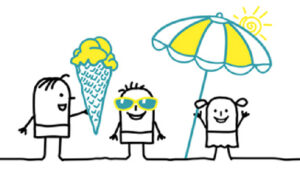The experience of most of us these days is that extreme weather is becoming more commonplace.
News and weather bulletins frequently seem to refer to the temperature, rainfall or snowfall being the highest or lowest on record, and the past couple of years have seen numerous weather ‘oddities’, from this spring’s unusual snowfalls in the US and the UK, to the record highs of 45C and more across Europe in the summer of 2019.
According to the UN, the past two decades have brought major increases in storms, droughts, wildfires and heatwaves.
All of this has implications for Customer Management and value creation.
Weather Affects Sales, Maybe More Than You Think
Weather matters to businesses because it affects customer behaviour and spending: it is one of the top three external drivers of demand (British Retail Consortium & Met Office, 2018).
On the surface, that’s obvious. If it rains, sales of umbrellas go up; if it’s hot, sales of swimwear rise instead. Households turn up the heating in a cold snap and the aircon in a heatwave.
But the effects go deeper than that. For instance, the weather can affect what cars people want or what houses or home furnishings they fall in love with.
In addition, weather influences how we purchase. In periods of cold or extreme heat, consumers are more likely to stay at home or by the poolside, reducing footfall and sales in physical stores.
But whereas heat can be a disincentive from shopping, even online, cold weather can turn people’s thoughts to nesting or holidays. The BRC / Met Office research found that wet or cold days can see a 12% increase in website traffic for furniture retailers.
Smart brands will use data, analytics and social listening to understand how weather affects their sales traffic, both physical and online.
But beware of relying on old data: the mass shift to digital interactions during the pandemic means that consumer behaviours during a 2021 heatwave could be different to those of the 2019 heatwave.
It’s Not Just About Sales and Spend
Demand for customer care and technical assistance can also be affected by the ups and downs of temperature or rainfall gauges.
At the most obvious level, an extreme weather event will hike up both BtoC and BtoB traffic to enquiry and support hotlines, as customers ask for advice or assistance, check or complain about service availability, or report faults or network outages.
But as with sales, brands may find that it goes deeper. For example, enforced time indoors could:
- increase demand for service activations on media or entertainment
- see people catching up with admin or worrying about their finances, leading to increased activity on refunds and claims management
- change BtoB customers’ opening or office hours, altering the service and support they want.
Here too, smart brands can use data to gauge if and how weather affects the level and nature of demand for customer care, technical assistance and other interactions.
The Feel-Good, or Feel-Bad, Factor in the Customer Journey
So far we have talked about the tangible effects of weather on the customer journey – that is, what and how they buy or what other support they seek.
But research has also shown the link between weather and consumers’ internal states and moods, which in turn influences their propensity to purchase (as well as crime levels and the behaviour of financial markets!)
Temperature, sunshine hours, rain, snow, humidity, wind speed and barometric pressure have all been shown to influence consumers’ behaviour, with low levels of humidity, high levels of sunlight, high temperatures and high pressure associated with the production of serotonin and positive mood.
This can feed through into sales behaviour: one study found that consumers in a positive mood are more likely to evaluate electrical appliances and cars favourably than those who say they are in a ‘neutral’ mood.
There’s also been a study showing that consumers would be prepared to pay more for gym membership or a drink on a sunny day than on other days.
One can extrapolate from this that fine weather creates a ‘feel-good factor’ that may apply in other customer interactions too. Data and speech analysis could be used to assess this, helping brands and CMO providers to engage with customers.
Don’t Overlook the Local Elements
When looking at these research trends in how weather links to consumer behaviour, it’s important not to overlook the local differences that could be in play here – in terms of not just the weather conditions but also customer responses to them.
It does seem that much of the English-language research on this topic is focused on the sun-seeking regions of Northern Europe and the more temperate states of the US – where sunshine and higher temperatures tend to be viewed as a positive.
The academics who found that ‘high’ temperatures cause positive moods among consumers may have reached some very different conclusions had they done the research in southern France and other parts of southern Europe when the thermometer hit 46C in 2019.
Analysis of weather, data and customer behaviours therefore needs to be done at local or regional level, as should decisions about how to respond to and manage them.
Is Your Sector Affected? Probably
Certain sectors have long known they are vulnerable to weather fluctuations. For example, energy networks and providers know they need to arrange additional customer management capacity during bad weather because their calls and messages from affected or anxious customers will surge.
In addition, most already deploy arrangements to keep customers proactively informed and updated – through social media, information lines, websites, text services and so on.
In retail too, brands know that product spend on items from clothing to garden furniture to food and drink is likely to be weather-sensitive.
In other sectors, the relationship may be less obvious and therefore overlooked. Yet, the research into the links between weather and customers’ internal states suggests that every customer interaction and every touchpoint in every sector could potentially be weather-sensitive.
With Weather Getting More Extreme, You Need to Think About This
The difficulty for all brands is knowing just what to expect from the weather – especially in those regions where it’s difficult to predict the next three hours, let alone the next three months.
However, by accepting that the weather can impact your business – and could do even more in future – there are ways to incorporate it into your customer management planning:
- Be agile. As in other areas of customer management, success comes from being able to respond quickly, having the flexibility to scale capacity and customer care approaches in response to events and demand.
- Draw on data and analytics to understand how the weather affects your customers’ behaviour.
- Seek out providers who have the scale to offer data analysis and digital solutions, but are local enough to understand what’s happening on the ground – or rather, in the sky.
- Look for resilience in your BPO providers – for example, whether they have work@home solutions like the Comdata Smart Hub operating model. If bad weather is going to affect travel, you want to know your provider can still operate.
- Use providers where there’s an emphasis on caring for people and communities. After all, their workforce may be affected by the same bad weather as the people they deal with. If staff feel safe, cared for and positive about their work, they will pass this onto your customers.
Those six points all lead us to one conclusion: with weather patterns becoming more extreme, there’s a stronger case for thinking further about this.
Those brands that identify and understand the behaviour shifts linked to weather have a good opportunity to build customer loyalty and create long-term customer value.
Author: Guest Author
Published On: 17th May 2021 - Last modified: 19th May 2021
Read more about - Guest Blogs, Comdata





































